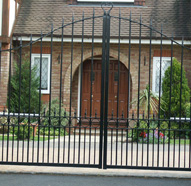Nick Perkins, training officer of the Door & Hardware Federation (DHF) writes of how installations of powered gates may be unsafe.
The Door and Hardware Federation entered the powered gate arena late in 2010 with encouragement from HSE after two separate child deaths in powered gate incidents in the same week and has seen a steady flow of companies joining its Powered Gate Group ever since. In 2014 two companies associated with one of the 2010 child death incidents were convicted of breaching the Health and Safety at Work Act. Interestingly the companies that were prosecuted were not the original installers, but those who had been involved in repair and maintenance of the gate since installation. Understandably today, those involved in repair and maintenance of powered gates are wisely, very sensitive to the safety of systems they repair or maintain.
The installation of new powered gate systems is covered by the Supply of Machinery (Safety) Regulations 2008. New systems should be accompanied by a Declaration of Conformity and be CE marked accordingly. The declaration is an assertion that the gate will be safe in use. Repair and maintenance companies are bound by the Health and Safety at Work Act 1974 to ensure that any works they undertake will result in a safe outcome.
Landlords and managing agents are bound by the Health and Safety at Work Act 1974 to ensure their gates are maintained in a safe condition.
Owners of workplace powered gates are bound by the Workplace Regulations 1992 and the Health and Safety at Work Act 1974 to ensure their gates are maintained in a safe condition. Any party whether owner or practitioner who by their actions or inactions causes injury to others faces the possibility of civil action for damages due to negligence; this applies equally to owners, maintainers, repairer or installers of powered gates.
Of course the legal framework is only part of the equation, as has been highlighted by HSE.
At a recent industry seminar HSE inspector Stuart Charles made the following observation.
“The prime function of identifying the responsibilities of duty holders is not to hold them accountable when things go wrong, but to ensure that things do not go wrong in the first place. Don’t think what do I need to do to avoid prosecution? But what do I need to do to make the situation safe?”
What this really means is that if your gate causes an injury or incident something has already gone wrong and you will be asked what steps you took to prevent the occurrence. The solution is to ensure adequate hazard identification and appropriate risk reduction. This can be a particularly difficult process with a powered gate system as most powered gates are bespoke designs quite often created on site or are adaptions of manual gates that were later automated. Conducting an adequate and effective assessment of these hazards and then applying effective and appropriate control measures is a job for an experienced properly trained and qualified powered gate specialist and is not to be taken lightly. The standard that provides much of the relevant guidance on this subject is BS EN 12453.
If you have, or are responsible for powered gates you should get them risk assessed by an experienced, trained and properly equipped expert. Then keep them regularly maintained to ensure that they stay in good safe and reliable working order. Keep a log of maintenance visits and repair work completed and make sure that your gate is re assessed as part of every maintenance visit. Also make sure that you have risk assessed the gate from the point of view of emergency egress, power outage etc. and be sure you and the users have received adequate training and know how to manually release the gate or isolate the power supply when required.
If your powered gate service provider comes to you with concerns over the safety of your gate system please understand that they are not just looking to protect themselves, but also they are attempting to protect you, your employees, tenants, clients or anybody else who may come into contact with your gate system. If you elect to leave the gate in service you do so entirely at your own volition and against good sound professional advice. More on powered gate safety can be found at:
•http://www.hse.gov.uk/safetybulletins/poweredgates.htm and
•http://www.hse.gov.uk/work-equipment-machinery/faq-powered-gates.htm.
About the DHF
Visit www.dhfonline.org.uk.









